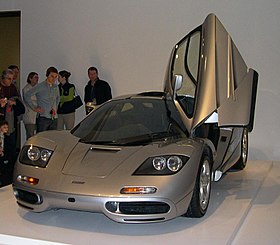Mclaren F1
| McLaren F1 | |
|---|---|
 |
|
| Overview | |
| Manufacturer | McLaren Automotive |
| Production | 1992–1998 (106 cars) |
| Assembly | Woking, Surrey, England |
| Designer | Gordon Murray & Peter Stevens |
| Body and chassis | |
| Class | Sports car (S) |
| Body style | 2-door coupé |
| Layout | Rear mid-engine, rear-wheel-drive |
| Doors | 2 |
| Related | McLaren F1 GTR |
| Powertrain | |
| Engine | 6.1 L BMW S70/2 V12 |
| Transmission | 6-speed manual |
| Dimensions | |
| Wheelbase | 2,718 mm (107.0 in) |
| Length | 4,287 mm (168.8 in) |
| Width | 1,820 mm (71.7 in) |
| Height | 1,140 mm (44.9 in) |
| Curb weight | 1,138 kg (2,509 lb) |
| Chronology | |
| Successor | McLaren P1 |
| McLaren F1 LM | |
|---|---|
 |
|
| Overview | |
| Manufacturer | McLaren Cars |
| Production | 1995 (5 produced) |
| Assembly | Woking, Surrey, England |
| Body and chassis | |
| Class | Supercar |
| Body style | 2-door coupé |
| Layout | RMR layout |
| Powertrain | |
| Engine | 6.1L S70/2 V12 |
| Transmission | 6-speed manual |
| Dimensions | |
| Wheelbase | 2,718 mm (107.0 in) |
| Length | 4,365 mm (171.9 in) |
| Width | 1,820 mm (71.7 in) |
| Height | 1,120 mm (44.1 in) |
| Kerb weight | 1,062 kg (2,341 lb) |
The McLaren F1 is a sports car designed and manufactured by McLaren Cars. Originally a concept conceived by Gordon Murray, he convinced Ron Dennis to back the project and engaged Peter Stevens to design the exterior and interior of the car. On 31 March 1998, the XP5 prototype set the record for the world's fastest production car, reaching 240.1 mph (386.4 km/h) with the rev limiter removed surpassing the 231 mph (372 km/h) reached with the XP3 prototype. The F1 surpassed the the Jaguar XJ220's 213 mph record from 1992, as well as the low production number RUF CTR2's 217 mph record from 1995. The McLaren's record lasted until the Bugatti Veyron 16.4 beat it in 2005 with a top speed of 253.81 mph (408.47 km/h).
The car features numerous proprietary designs and technologies; it is lighter and has a more streamlined structure than many modern sports cars, despite having one seat more than most similar sports cars, with the driver's seat located in the centre (and slightly forward) of two passengers' seating positions, providing driver visibility superior to that of a conventional seating layout. It features a powerful engine and is somewhat track oriented, but not to the degree that it compromises everyday usability and comfort. It was conceived as an exercise in creating what its designers hoped would be considered the ultimate road car. Despite not having been designed as a track machine, a modified race car edition of the vehicle won several races, including the 24 Hours of Le Mans in 1995, where it faced purpose-built prototype race cars. Production began in 1992 and ended in 1998. In all, 106 cars were manufactured, with some variations in the design.
In 1994, the British car magazine Autocar stated in a road test regarding the F1, "The McLaren F1 is the finest driving machine yet built for the public road." They further stated, "The F1 will be remembered as one of the great events in the history of the car, and it may possibly be the fastest production road car the world will ever see." In 2005, Channel4 placed the car at number one on their list of the 100 greatest cars, calling it "the greatest automotive achievement of all time". Notable past and present McLaren F1 owners include Elon Musk,Jay Leno, and the Sultan of Brunei.
...
Wikipedia
